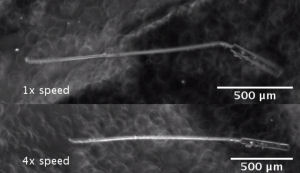
MIT scientists have created genetic circuits in bacterial cells that not only perform logic functions, but also remember the results, which are encoded in the cell’s DNA and passed on for dozens of generations. The circuits, described in aNature Biotechnology paper, could be used as long-term environmental sensors, control mechanisms for biomanufacturing, or to program stem cells to differentiate into other cell types.
“Almost all of the previous work in synthetic biology that we’re aware of has either focused on logic components or on memory modules that just encode memory. We think complex computation will involve combining both logic and memory, and that’s why we built this particular framework to do so,” said lead researcher Timothy Lu.
Lead author of the paper, Piro Siuti, explained that in previously engineered cellular logic circuits, the result is only available as long as the original stimuli are present: once they disappear, the circuit shuts off until another stimulus comes along. To create non-volatile bio-memory, Siuti said the researchers used enzymes known as recombinases, which can cut out stretches of DNA, flip them, or insert them. Sequential activation of those enzymes allows the circuits to count events happening inside a cell.
Co-researcher Timothy Lu designed the new circuits so that the memory function is built into the logic gate itself. With a typical cellular AND gate, the two necessary inputs activate proteins that together turn on expression of an output gene. However, in the new circuits, the inputs stably alter regions of DNA that control the production of certain proteins (in this case, green fluorescent protein (GFP)). These regions, known as promoters, recruit the cellular proteins responsible for transcribing the GFP gene into messenger RNA, which then directs protein assembly.
For example, in one circuit described in the paper, two DNA sequences called terminators are interposed between the promoter and the output gene. Each of these terminators inhibits the transcription of the output gene and can be flipped by a different recombinase enzyme, making the terminator inactive.
Each of the circuit’s two inputs turns on production of one of the recombinase enzymes needed to “flip” a terminator. In the absence of either input, GFP production is blocked. If both are present, both terminators are flipped, resulting in their inactivation and subsequent production of GFP.
Once the DNA terminator sequences are flipped, they can’t return to their original state – the memory of the logic gate activation is permanently stored in the DNA sequence. Lu said experiments show that the sequence gets passed on for at least 90 generations. Scientists wanting to read the cell’s history can either measure its GFP output, which will stay on continuously, or if the cell has died, they can retrieve the memory by sequencing its DNA.
Using this design strategy, the researchers can create all two-input logic gates and implement sequential logic systems. “It’s really easy to swap things in and out,” says Lu. “If you start off with a standard parts library, you can use a one-step reaction to assemble any kind of function that you want.”
The development may open the door for novel cellular computing applications such as digital-to-analog converters to track continuous levels of gene expression. That type of circuit could provide better control over the production of cells that generate biofuels, drugs or other useful compounds. Instead of creating circuits that are always on, or using promoters that need continuous inputs to control their output levels, scientists could transiently program the circuit to produce at a certain level. The cells and their progeny would always remember that level, without needing any more information.
The platform could also allow scientists to more accurately control the fate of stem cells as they develop into other cell types. Lu is now working on engineering cells to follow sequential development steps, depending on what kinds of inputs they receive from the environment.
Related:
Discuss this article in our forum
Artificial neural network created from DNA
Molecular “robot” built from DNA
Electronic components made from human blood
Heredity and evolution seen in synthetic DNA










Comments are closed.